
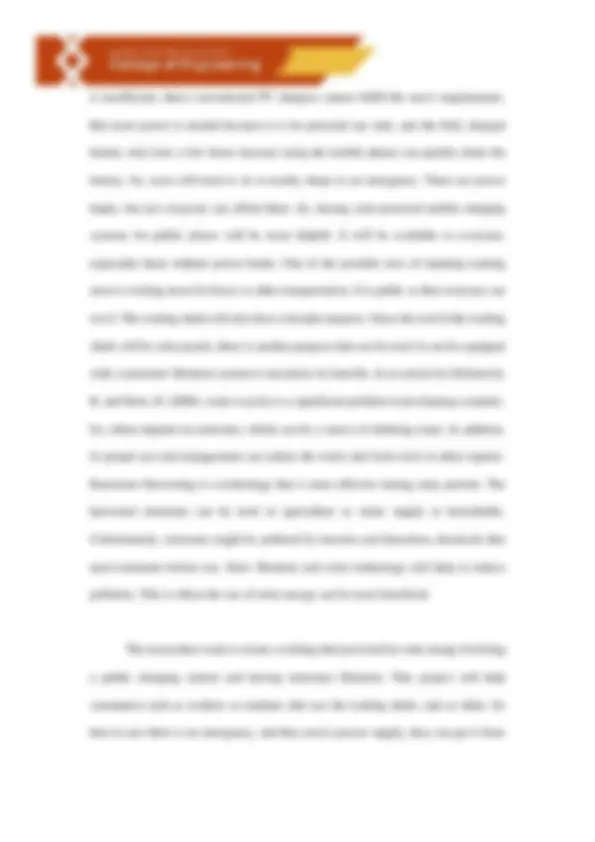
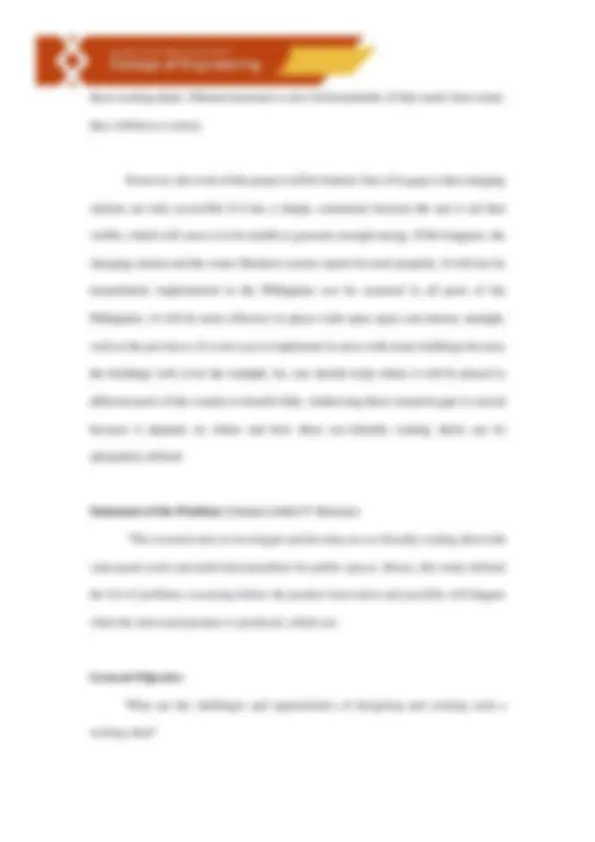




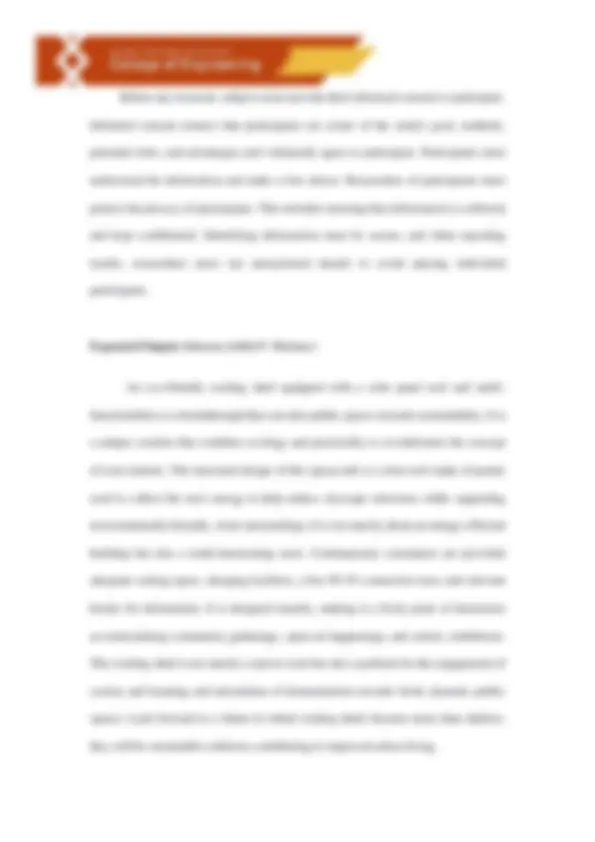
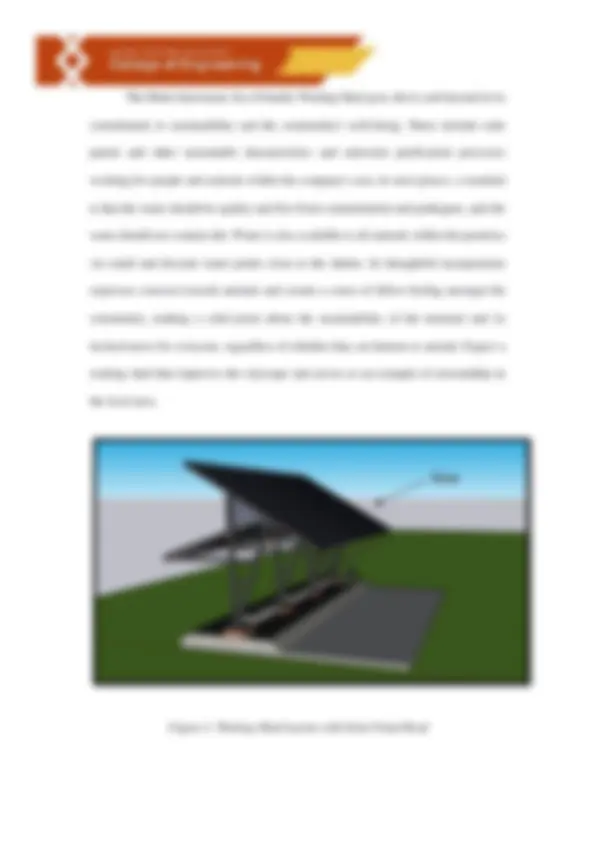
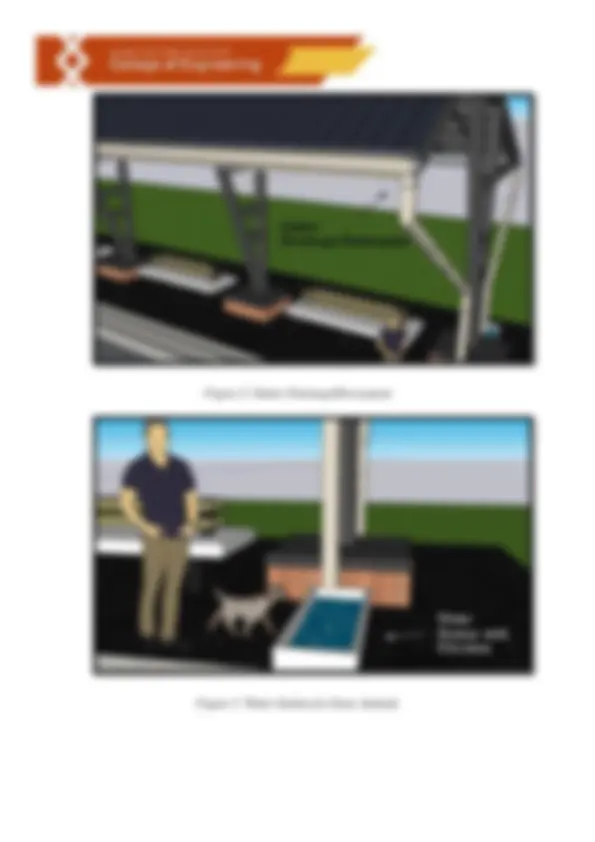






Study with the several resources on Docsity

Earn points by helping other students or get them with a premium plan


Prepare for your exams
Study with the several resources on Docsity

Earn points to download
Earn points by helping other students or get them with a premium plan
Community
Ask the community for help and clear up your study doubts
Discover the best universities in your country according to Docsity users
Free resources
Download our free guides on studying techniques, anxiety management strategies, and thesis advice from Docsity tutors
This research aims to develop an eco-friendly waiting shed with solar panel roofs and multi-functionalities for public spaces. The primary goal is to use renewable solar energy to charge devices and filter rainwater for community usage. The study explores integrating solar panels into public facilities, addressing public attitudes and the feasibility of a rainwater collection system. The eco-friendly waiting shed combines sustainability, energy efficiency, and functionality, serving as an example of sustainable infrastructure and assisting the local community.
Typology: Schemes and Mind Maps
1 / 21

This page cannot be seen from the preview
Don't miss anything!














Submitted by: Aratea, Carl John S. Contreras, Llanesse Bienne A. De Leon, Patricia Clariz P. Espela, Mary Anna Trexia C. Leonardo, Christian S. Mariano, Johanna Johfel P. BSIE 4 A Submitted to: Lucky Gem L. Asibuque, CIE
Introduction (Llanesse Bienne A. Contreras) In today's time, the extraction of energy is a critical juncture. The world must move to clean, renewable energy sources because of climate change and the progressive depletion of fossil fuel supplies. Solar energy is at the forefront among the different types of pure resources. However, many other clean energies can also be used, such as wind, hydroelectric, geothermal, and other alternative energy sources that can help. Solar energy is a remarkable and abundant resource that uses the sun's power to generate electricity and heat. This energy is obtained by capturing sunlight using photovoltaic cells or solar panels. One of the great features of solar energy is that it is renewable. The sun is an inexhaustible energy source, providing us with more energy in one hour than the entire world consumes in a year. Moreover, solar energy is clean and emits no greenhouse gases, making it essential for mitigating climate change, according to an article by Udayalakshmi J.K. and Sheikh Mohammed S. (2018). In today's age of technology, solar energy will be helpful and valuable; one of its uses is charging stations. In recent years, we have been in evolutionary changes where mobile phone technology has become available, its use has become functional, and the applications that can be placed on it. Upgraded hardware and more complex software leads to more energy consumption. Because of this, phones are rapidly increasing in Abnormal Battery Drain (ABD) problems. Portable mobile phone chargers that generate electricity using photovoltaic cells are introduced as an alternative to the battery banks. It consists of a battery to store the energy generated by the PV cell. Since the amount of electricity, the PV cells generate
these waiting sheds. Filtered rainwater is also for households; if they need clean water, they will have a source. However, the work of this project will be limited. One of its gaps is that charging stations are only accessible if it has a charge, sometimes because the sun is not that visible, which will cause it to be unable to generate enough energy. If this happens, the charging station and the water filtration system cannot be used properly. It will not be immediately implemented in the Philippines nor be assumed in all parts of the Philippines. It will be more effective in places with open space and intense sunlight, such as the provinces. It is not easy to implement in areas with many buildings because the buildings will cover the sunlight. So, one should study where it will be placed in different parts of the country to benefit fully. Addressing these research gaps is crucial because it depends on where and how these eco-friendly waiting sheds can be adequately utilized. Statement of the Problem (Johanna Johfel P. Mariano) `This research aims to investigate and develop an eco-friendly waiting shed with solar panel roofs and multi-functionalities for public spaces. Hence, this study defined the list of problems occurring before the product innovation and possibly will happen when the innovated product is produced, which are: General Objective What are the challenges and opportunities of designing and creating such a waiting shed?
Specific Objectives
According to Oisamoje & Eguono Oisamoje (2013), solar energy has economic and environmental benefits for every country. Thus, it is crucial to the economy of any country's cost-effectiveness. Together with other advantages, it promotes micro- industry growth and directly employs workers. They have further illustrated that solar energy systems are produced due to certain factors. In contrast, when selecting whether or not to use solar energy, factors other than economic ones are considered, such as pollution, the production of greenhouse gasses, and the security of the energy supply, among others (Oisamoje & Eguono Oisamoje, 2015). Due to their efficiency, accessibility, and scalability, solar panels—which use sunlight to produce energy—are growing in popularity. But it's impossible to ignore how solar energy impacts the environment. Installation, use, and removal of solar panels can all significantly harm the environment. Therefore, evaluating solar panels' environmental impact and life cycle is crucial. The design of the shed could incorporate a rainwater collection and storage system to gather and conserve rainwater for various uses, such as watering nearby plants or cleaning the shelter. This saves water resources and promotes sustainability. Rainwater that falls is primarily not utilized and only becomes surface runoff. Indonesia has a potential high rainfall every year to be used by the community. One method to collect rainwater is to build a Rainwater Harvesting System (RWHS) (A. R. Asnaning et al.2019). According to C. S. Silvia and M. Safriani (2018), Rainwater Harvesting is an effort to utilize rainwater for daily needs. The basic principle is to drain rainwater that falls from the roof's surface through a gutter; then, it is collected into the reservoir. Rainwater harvesting is implemented by striving to use cheap and efficient costs but still has enormous benefits for the need for clean water for the community. Rainwater
harvesting collects and stores rainwater from roofs, parks, roads, etc. This rainwater runoff can be held or replenished into groundwater (aquifer layer). This technique conserves water and can save costs and reduce our impact on the environment, reducing runoff volume and peak flow, thereby reducing flooding. Replenishing groundwater is a solution to the problem of water shortages in the dry season. Some fundamental reasons for a Rain Water Harvesting system include saving water and preventing flooding by reducing runoff and letting it seep into the ground (S. P. Singh et al., 2018). Rainwater harvesting is a simple and low-cost water supply technique that captures and stores rainwater from roofs of buildings and catchments for domestic, agricultural, industrial, and environmental purposes. Although harvesting rainwater and runoff has been extensively tested and researched, this practice has yet to be widely practiced in the community (A. Mulyadi et al. 2019). The study described above demonstrates how many elements can be combined to produce an environmentally friendly waiting shed with solar panels and a variety of applications that can serve as an example of sustainable infrastructure while also assisting the neighborhood and commuters. This study aims to create a solar-powered waiting shed that is environmentally beneficial. It also emphasizes reducing the harmful effects on the environment while enhancing the general experience of transit customers. Bon the environment while also improving the broad expertise of transit customers. In recent years, the world's installed photovoltaic (PV) capacity has increased. In 2013, a more than 37 GW PV capacity was established worldwide, accumulating a cumulative total of approximately 137 GW. While Europeans have a share of the world PV market, it has decreased from 70% in 2011 to 28% in 2013; Asia now has the largest share of PV installations. While the installation of PVs is increasing, the price has decreased by 6-7% per year since 1998. The most significant substantial price decline
use of solar panels in public facilities. A gap analysis in these areas could help identify potential barriers to implementation and areas where more education and outreach may be necessary. Existing Design Scope and delimitation (Carl Jhon S. Aratea) This study aims to design and build an innovative waiting shed powered by solar energy heavily designed for public use. It will be utilized as a public charging station with rainwater filtration. This project will aid the commuters, whether workers or students, who operate the waiting sheds. This waiting shed is an innovation for public use as there will be public power consumption and filtered rainwater at their disposal. The scope of the study is limited to the design and construction of the waiting shed powered by solar energy. The researchers will develop or manufacture the hardware components needed to attain the feasibility of the study. The study will be evaluated based on the waiting shed powered by solar energy. The researchers believe that the system has the potential to benefit the commuters of Bulacan State University – Bustos Campus, where there is a lack of innovative public structure. That being said, the project will not only provide shelter
during poor and intense weather conditions but also provide public charging stations and filtered rainwater for their consumption while keeping the initiative sustainable as it is powered by solar energy. However, the researchers also recognize that the waiting shed powered by solar energy has its drawbacks and limitations. For example, the weather conditions, specifically the lack of solar energy, will affect the waiting shed’s effectiveness and efficiency. Despite its limitations, the researchers are highly convinced that this study has the potential to aid commuters while providing more public service. They aspire their work will be a stepping stone for future researchers and developers to create a more innovative and effective general structure. Research Design (Mary Anna Trexia C. Espela) The main goal of this project is to evaluate the sustainability, environmental responsibility, and satisfaction of users of traditional waiting sheds and solar-powered waiting sheds with multiple uses in public areas. The essence of this research lies in its before-and-after comparative design. The researchers aim to strictly evaluate the impact of the "Eco-friendly waiting shed with solar panels and multifunctionalities: a sustainable solution for public spaces" development within the Baliuag Bulacan community, comparing the users' present experience of modern waiting shed designs. This study will use purposive sampling to learn more about the preferences and experiences of various user groups. The researchers may choose participants from commuters, tourists, senior citizens, and parents with young children, among other
Before any research, subjects must provide their informed consent to participate. Informed consent ensures that participants are aware of the study's goal, methods, potential risks, and advantages and voluntarily agree to participate. Participants must understand the information and make a free choice. Researchers of participants must protect the privacy of participants. This includes ensuring that information is collected and kept confidential. Identifying information must be secure, and when reporting results, researchers must use anonymized details to avoid placing individual participants. Expected Output (Johanna Johfel P. Mariano) An eco-friendly waiting shed equipped with a solar panel roof and multi- functionalities is a breakthrough that can take public spaces towards sustainability. It is a unique creation that combines ecology and practicality to revolutionize the concept of wait stations. The structural design of this spacecraft is a solar roof made of panels used to collect the sun's energy to help reduce cityscape emissions while supporting environmentally friendly, clean surroundings. It is not merely about an energy-efficient building but also a multi-functioning oasis. Contemporary commuters are provided adequate seating space, charging facilities, a free Wi-Fi connection zone, and relevant kiosks for information. It is designed smartly, making it a lively point of interaction accommodating community gatherings, open-air happenings, and artistic exhibitions. This waiting shed is not merely a spot to wait but also a podium for the engagement of society and learning and articulation of determination towards fresh, dynamic public spaces. Look forward to a future in which waiting sheds become more than shelters; they will be sustainable solutions contributing to improved urban living.
The Multi-functional, Eco-Friendly Waiting Shed goes above and beyond in its commitment to sustainability and the community's well-being. These include solar panels and other sustainable characteristics and rainwater purification processes working for people and animals within the company's area. In most places, a standard is that the water should be quality and free from contamination and pathogens, and the water should not contain dirt. Water is also available to all animals within the premises via small and discrete water points close to the shelter. Its thoughtful incorporation expresses concern towards animals and creates a sense of fellow feeling amongst the community, making a solid point about the sustainability of the terminal and its inclusiveness for everyone, regardless of whether they are human or animal. Expect a waiting shed that improves the cityscape and serves as an example of stewardship in the local area. Figure 1: Waiting Shed Layout with Solar Panel Roof Solar Panel
Figure 4 : Available Seats Figure 5 : Available Outlets/Charging Ports Seats Outlets
Products Parts & Description (Johanna Johfel P. Mariano) Solar Roofs A sustainable and environmentally beneficial design innovation for waiting sheds is solar roofing. They entail mounting solar panels on the top of a shelter that is being built, utilizing sunlight to provide electricity that is clean and renewable. This energy can be used within the shelter to run lighting, charging stations, and other amenities, minimizing the need for conventional electrical sources and bringing down operating expenses. Waiting shelters with solar roofs can save money and the environment by lowering carbon emissions while also improving energy efficiency. As a visible reminder of the dedication to sustainability, they frequently also have a beautiful and contemporary appearance. Overall, solar roofing for waiting sheds provide an innovative and practical way to improve public places while lowering their environmental impact. Gutter Drainage and Downspout The waiting shed's gutter drainage and downspouts are essential to the rainwater filtration system. These components are intended to collect roof- generated rainfall and transport it to a filtration system via a network of pipes or channels. Rainwater falling on a roof
Gantt chart (Patricia Clariz P. De Leon)
References A. R. Asnaning, S. Surya, A. E. Saputra, and D. Ahyuni, “Water Conservation with Rainwater Harvesting System in Lampung Province (Case Study in State Polytechnic of Lampung Campus Area),” J. Sci. Appl. Technol., vol. 2, no. 1, pp. 176–182, 2019, doi: 10.35472/281453. C. S. Silvia and M. Safriani, “Analisis Potensi Pemanenan Air Hujan Dengan Teknik Rainwater Harvesting Untuk Kebutuhan Domestik,” vol. 4, no. 1, pp. 62–73, 2018 Carlisle, J. E., Kane, S. L., Solan, D., Bowman, M., & Joe, J. C. (2015). Public attitudes regarding large-scale solar energy development in the U.S. Renewable & Sustainable Energy Reviews, 48 , 835–847. https://doi.org/10.1016/j.rser.2015.04.